
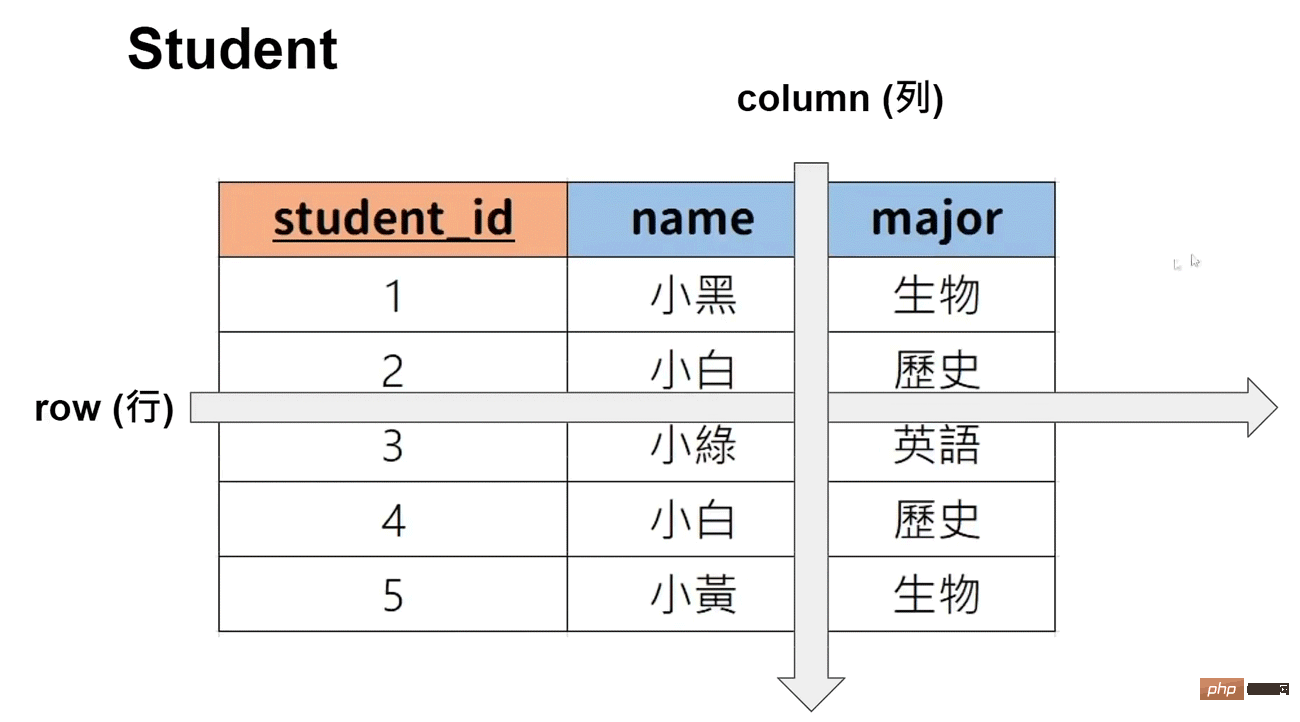
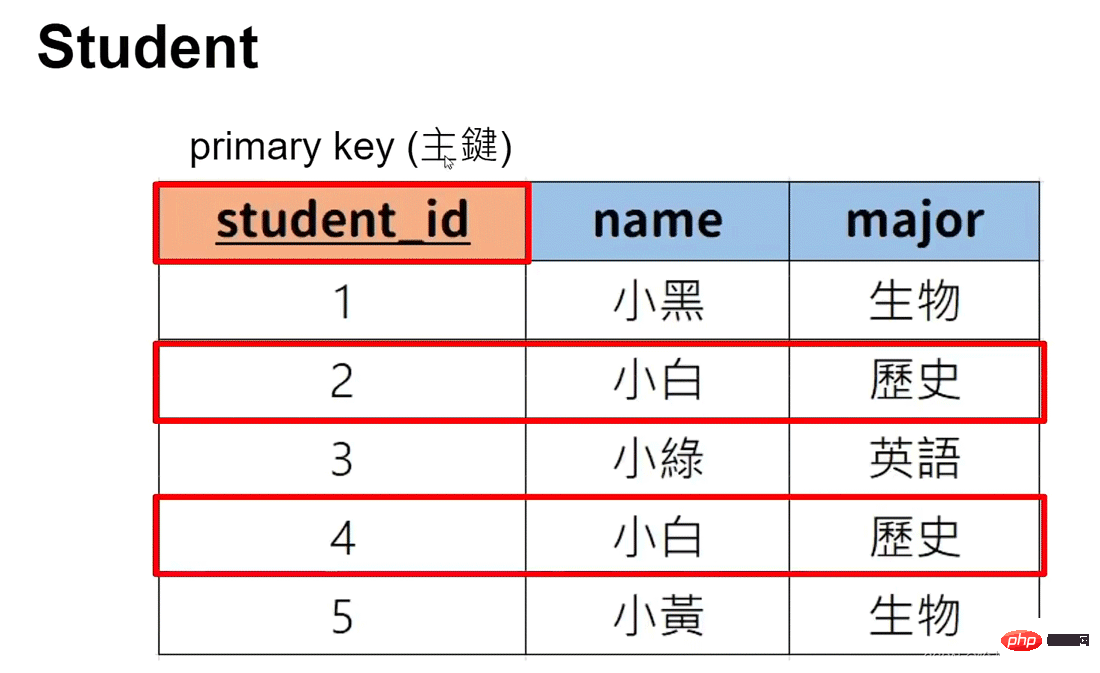
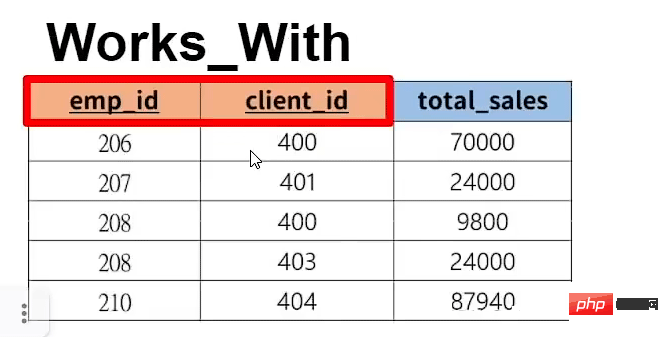
Primärschlüssel: kann die Informationen eindeutig darstellen (mehrere Listen können als Primärschlüssel festgelegt werden)
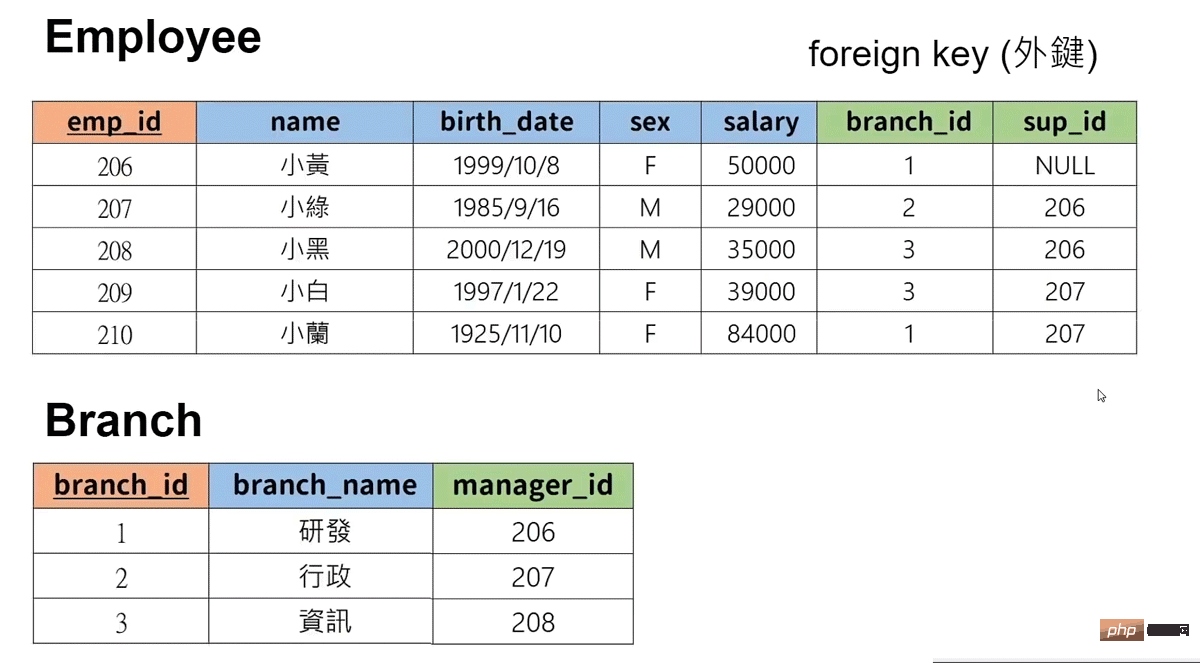
Außerhalb der Einstellung Der Schlüssel verbindet die Tabellen und der Fremdschlüssel muss der Primärschlüssel anderer Tabellen sein (der Fremdschlüssel kann auch den Primärschlüssel seiner eigenen Tabelle festlegen)
CREATE DATABASE `sql_tutorial`; --创建资料库 SHOW databases; --展示资料库 drop database `sql_tutorial`; --删除资料库
;Format des Endbefehls
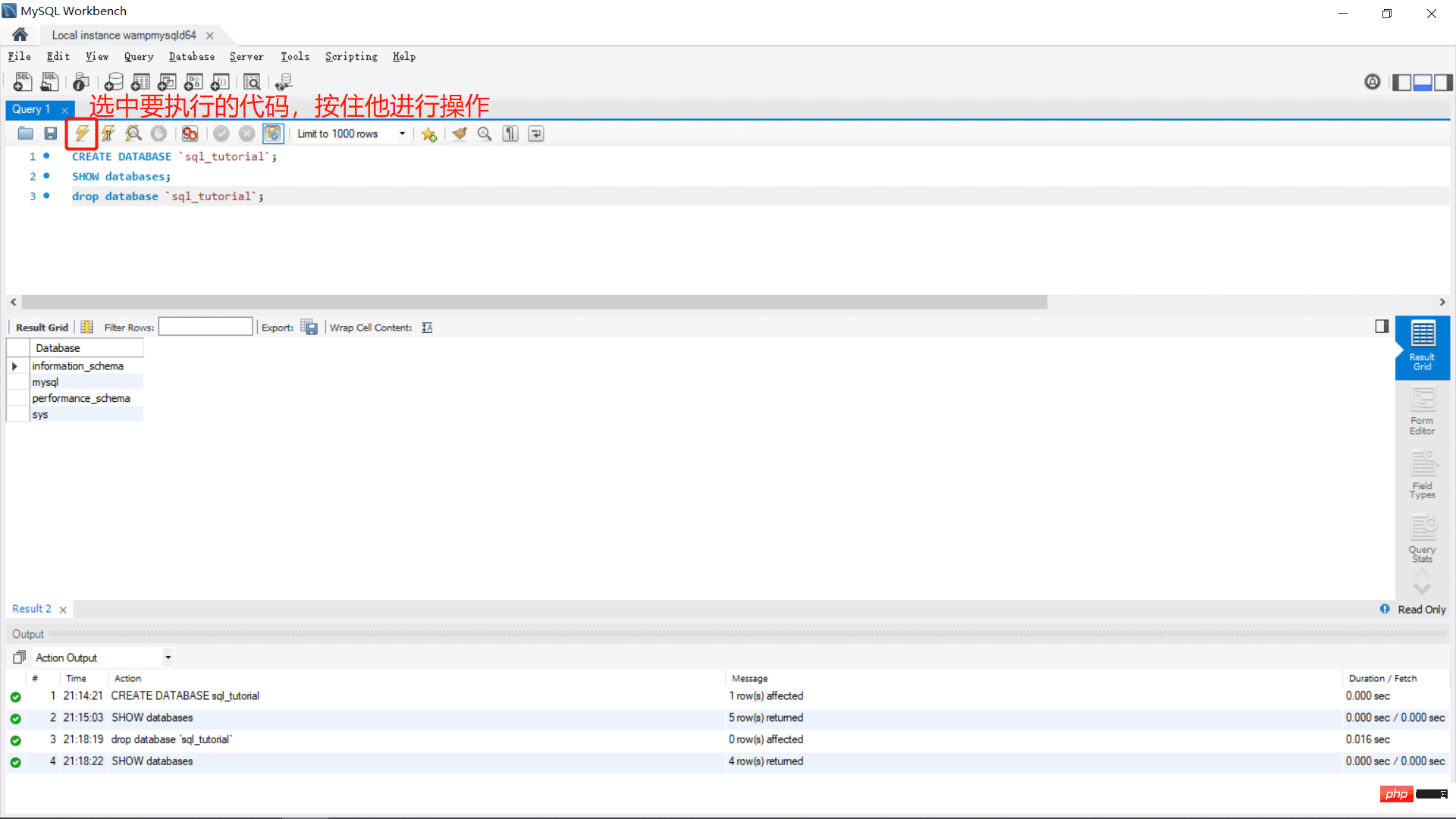
MySQL-Datenformat:
CREATE DATABASE `sql_tutorial`; -- 创建资料库
SHOW databases; -- 展示资料库
use `sql_tutorial`; -- 选择使用的资料库
create table student(
`student_id` int primary key, -- 第一列
`name` varchar(20), -- 第二列
`major` varchar(20) -- 第三列,20指的是最大字符长度
); -- 创建表格并设计属性
describe `student`; -- 展示表格
drop table `student`; -- 删除表格
alter table `student` add gpa decimal(3,2); -- 增加资料属性
alter table `student` drop column gpa ; -- 删除资料属性create table student(
`student_id` int primary key, -- 第一列
`name` varchar(20), -- 第二列
`major` varchar(20) -- 第三列,20指的是最大字符长度
); -- 创建表格并设计属性
select * from `student`; -- 搜索表格的全部资料
insert into `student` values(1,'小白','历史'); -- 写入表格数据
insert into `student` values(2,'小黑','生物'); -- 写入表格数据
insert into `student` values(3,'小绿',null); -- 写入表格数据,null为空
insert into `student`(`name`,`major`,`student_id`) values('小蓝','英语','4'); -- 按照设置写入表格数据
insert into `student`(`major`,`student_id`) values('英语','5'); -- 按照设置写入表格数据,没有的数据则为空白nullcreate table student(
`student_id` int primary key, -- 第一列
`name` varchar(20) not null, -- 第二列,not null指这个属性不可以为空
`major` varchar(20) unique -- 第三列,20指的是最大字符长度,unique指每个值不可以重复
); -- 创建表格并设计属性
create table student(
`student_id` int primary key auto_increment, -- 第一列,auto_increment自动会加一
`name` varchar(20), -- 第二列,not null指这个属性不可以为空
`major` varchar(20) default '历史' -- 第三列,20指的是最大字符长度,default指预设值,如果没有写该属性,则为预设值
); -- 创建表格并设计属性
drop table `student`;
select * from `student`; -- 搜索表格的全部资料
insert into `student`(`name`,`major`) values('小蓝','英语'); -- 按照设置写入表格数据
insert into `student`(`name`) values('小黑'); -- 按照设置写入表格数据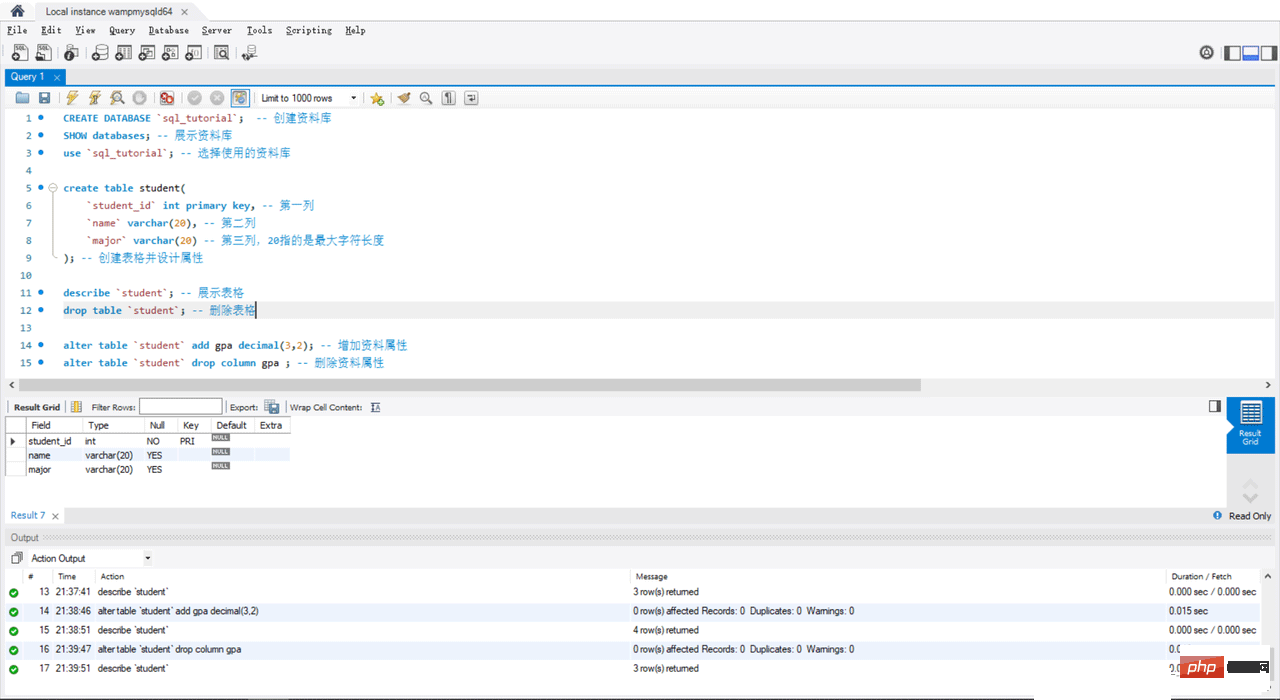 6. Informationen ändern und löschen
6. Informationen ändern und löschen
set sql_safe_updates = 0; -- 把预设更新模式关闭,这样更新操作才可以成功
create table student(
`student_id` int primary key auto_increment, -- 第一列
`name` varchar(20), -- 第二列
`major` varchar(20), -- 第三列,20指的是最大字符长度
`score` int
); -- 创建表格并设计属性
drop table `student`;
select * from `student`; -- 搜索表格的全部资料
insert into `student`(`name`,`major`) values('小蓝','英语'); -- 按照设置写入表格数据
insert into `student`(`name`,`major`) values('小白','化学'); -- 按照设置写入表格数据
insert into `student`(`name`,`major`) values('小黑','生物'); -- 按照设置写入表格数据
update `student` -- 更新哪个表格
set `major` = '英语文学' -- 将什么更新成什么
where `major` = '英语'; -- 将其中谁的什么进行更新
-- 还可以进行多个更新
update `student` -- 更新哪个表格
set `major` = '生化' -- 将什么更新成什么
where `major` = '生物' or `major` = '化学' ; -- 将其中谁的什么进行更新
update `student` -- 更新哪个表格
set `name` = '小辉',`major` = '生化' -- 将什么更新成什么
where `student_id`=1 ; -- 将其中谁的什么进行更新
-- 不加条件则都改
update `student` -- 更新哪个表格
set `major` = '物理'; -- 将其中谁的什么进行更新,都改成了生化
delete from `student`
where `student_id` = 3; -- 删除表格中的数据
-- 条件也可以设置多个
delete from `student`
where `name` = '小白' and `major`='物理'; -- 删除表格中的数据
delete from `student`; -- 删除所有的资料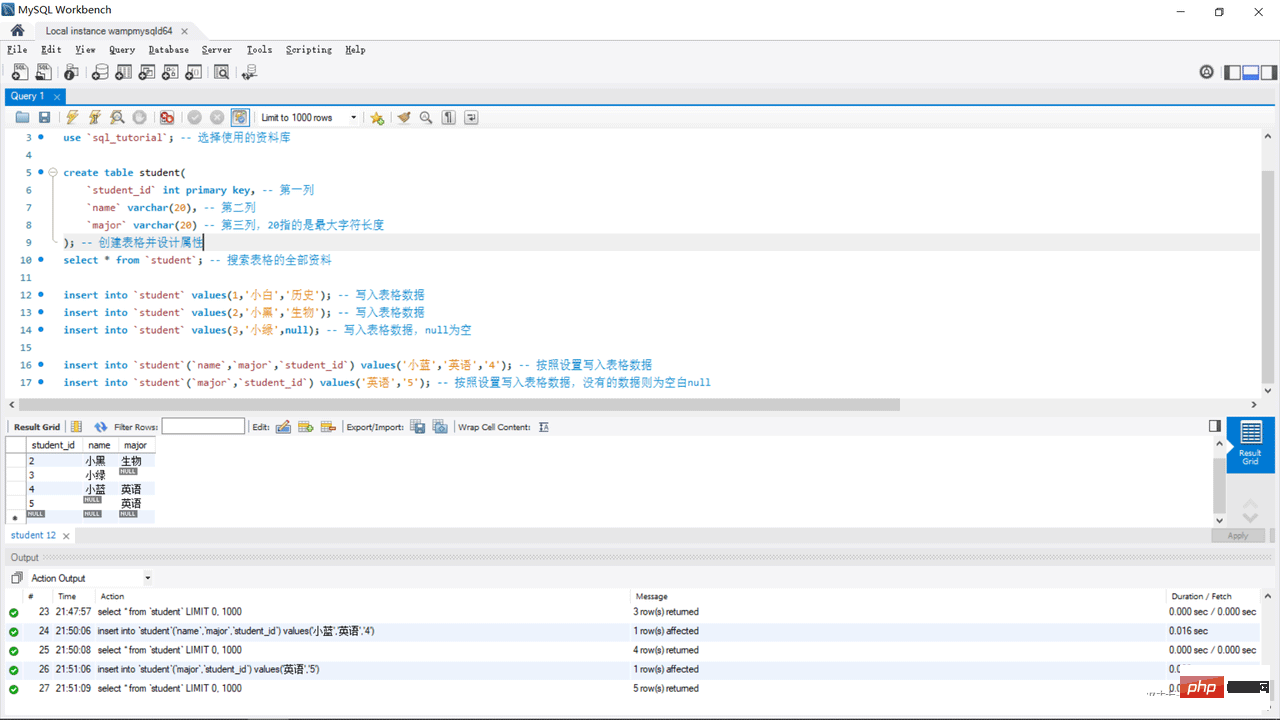 7 Informationen erhalten
7 Informationen erhalten-- 取得资料 select * from `student`; -- 取得表格的全部资料 select `name` from `student`; -- 只取得表格的对应数据 select `name`, `major` from `student`; -- 取得表格的对应多个数据 select * from `student` ORDER BY `score`; -- 取得表格的全部资料,并排序(默认正序) select * from `student` ORDER BY `score` DESC; -- 取得表格的全部资料,并排序(由高到低,asc是由低到高) select * from `student` ORDER BY `score` ,`student_id`; -- 取得表格的全部资料,并排序(先有score做排序,score中相同的再由student_id做排序) select * from `student` LIMIT 3 ; -- 限制资料范围 select * from `student` ORDER BY `score` LIMIT 3 ; -- 排序并限制资料范围 select * from `student` where `major`= '英语'; -- 查找对应资料 select * from `student` where `major`= '英语' and `student_id` = 1; -- 查找对应资料(多条件) select * from `student` where `major` in('历史','英语','生物'); -- 查找对应资料(多条件)1
CREATE DATABASE `sql_tutorial`; -- 创建资料库
SHOW databases; -- 展示资料库
use `sql_tutorial`; -- 选择使用的资料库
create table `employee`(
`emp_id` int primary key, -- 第一列
`name` varchar(20), -- 第二列,20指的是最大字符长度
`bath_date` date, -- 第三列
`sex` varchar(1),
`salary` int,
`branch_id` int,
`sup_id` int
); -- 创建表格并设计属性
create table `branch`(
`branch_id` int primary key , -- 第一列
`branch_name` varchar(20), -- 第二列
`manager_id` int, -- 第三列,20指的是最大字符长度
foreign key (`manager_id`) references `employee`(`emp_id`) on delete set null -- 设置好外键(选择什么是并对应什么表格的什么属性)
); -- 创建表格并设计属性
-- 补充外键(外表格对应)
alter table `employee` -- 在什么表格上进行更新
add foreign key(`branch_id`) -- 在他的什么属性上
references `branch`(`branch_id`) -- 从哪的什么属性对应
on delete set null;
-- 补充外键(内表格对应)
alter table `employee` -- 在什么表格上进行更新
add foreign key(`sup_id`) -- 在他的什么属性上
references `employee`(`emp_id`) -- 从哪的什么属性对应
on delete set null;
create table `client`(
`client_id` int primary key , -- 第一列
`client_name` varchar(20), -- 第二列
`phone` varchar(20) -- 第三列,20指的是最大字符长度
); -- 创建表格并设计属性
create table `works_with`(
`emp_id` int, -- 第一列
`client_id` int, -- 第二列
`total_sales` int, -- 第三列,20指的是最大字符长度
primary key(`emp_id`,`client_id`),
foreign key (`emp_id`) references `employee`(`emp_id`) on delete cascade, -- 设置好外键(选择什么是并对应什么表格的什么属性)
foreign key (`client_id`) references `client`(`client_id`) on delete cascade -- 设置好外键(选择什么是并对应什么表格的什么属性)
); -- 创建表格并设计属性
-- 当增加资料冲突的时候可以先将其设置为null然后再更新
insert into `branch` values(1,'研发',null);
insert into `employee` values(206,'xiaohuang','1998-10-08','F',50000,1,null);
update `branch`
set `manager_id` = 206
where `branch_id` = 1;-- 取得对应表格所有资料 select * from `employee`; -- 取得对应表格所有资料并排序(默认低到高) select * from `employee` order by `salary`; -- 低为加desc -- 增加限制取出条件 select * from `employee` order by `salary` desc limit 3 ; -- 取出前三高 -- 取出对应属性 select `name` from `employee` ; -- 取出对应属性的内容(且不重复) select distinct `name` from `employee` ;
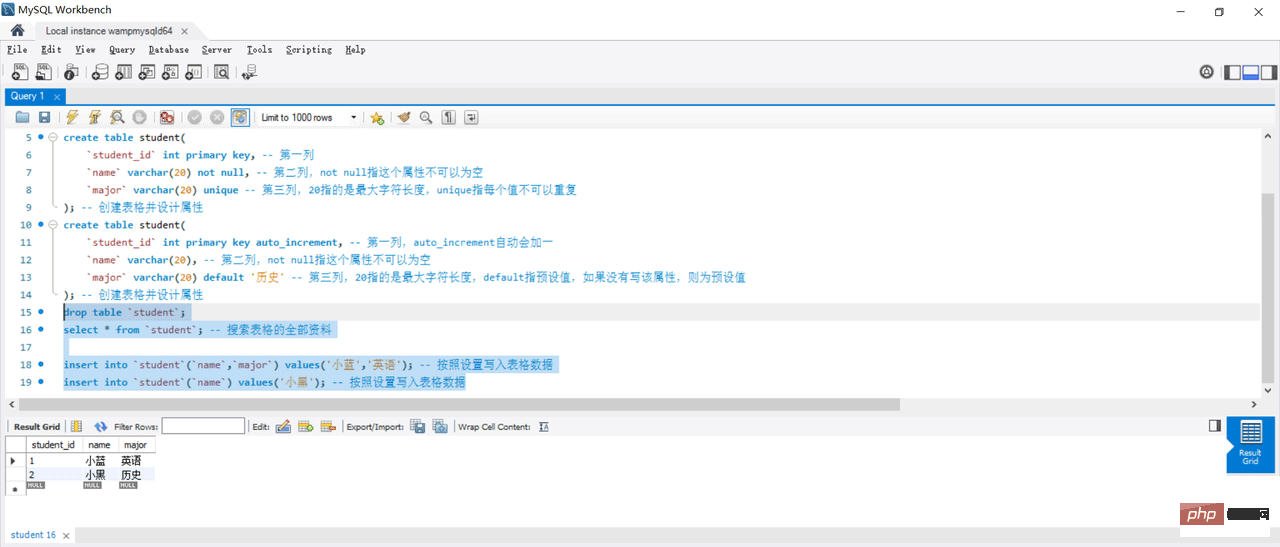 10. Aggregationsfunktion
10. Aggregationsfunktion-- 取得人数 select count(*) from `employee`; -- 统计几笔资料 select count(`sup_id`) from `employee`; -- 统计对应属性资料个数(null不计入) -- 增加条件取数 select count(*) from `employee` where `bath_date` > '1970-01-01' and `sex` = 'F'; -- 统计几笔资料 -- 计算对应的属性的平均 select avg(`salary`) from `employee`; -- 计算对应的属性的总和 select sum(`salary`) from `employee`; -- 取得最高的 select max(`salary`) from `employee`; -- 取得最低的 select min(`salary`) from `employee`;
-- %表示多个子元,_表示一个子元 -- 取得尾数335的数据 select * from `client` where `phone` like '%335'; -- 取得姓艾的 select * from `client` where `client_name` like '艾%'; -- 取得生日是10月的 select * from `employee` where `bath_date` like '_____10%';
12. Union#🎜🎜 #
-- 员工与客户合并为一列(类型必须相同) select `name` from `employee` union select `client_name` from `client`; -- 多个数据合并为多列(类型必须相同) select `emp_id`, `name` from `employee` union select `client_id`, `client_name` from `client`; -- 多个数据合并为多列(类型必须相同)顺便改个名 select `emp_id` as `total_id`, `name` as `total_name` from `employee` union select `client_id`, `client_name` from `client`;
-- 连接 -- 取得所有部门经理名字,这就需要先确定部门再确定经理(二表相连) select * from `employee` join `branch` on `emp_id` = `manager_id`; -- 还可以写成 select * from `employee` join `branch` on `employee`.`emp_id` = `branch`.`manager_id`; -- 附加条件 select * from `employee` left join `branch` on `employee`.`emp_id` = `branch`.`manager_id`; -- 左边的表格(join的左边)返回全部数据,右边的必须满足才可
-- 查询套查询
select `name` from `employee`
where `emp_id` = (
select `manager_id`
from `branch`
where `branch_name` = '研发'
); -- 查找研发部门的经理名字
select `emp_id` from `employee`
where `emp_id` in (
select `emp_id`
from `works_with`
where `total_sales` > 50000
); -- 销售资金超50000的人有哪些 `branch_id` int primary key , -- 第一列
`branch_name` varchar(20), -- 第二列
`manager_id` int, -- 第三列,20指的是最大字符长度
foreign key (`manager_id`) references `employee`(`emp_id`) on delete set null -- 设置好外键(选择什么是并对应什么表格的什么属性)
); -- 创建表格并设计属性
create table `works_with`(
`emp_id` int, -- 第一列
`client_id` int, -- 第二列
`total_sales` int, -- 第三列,20指的是最大字符长度
primary key(`emp_id`,`client_id`),
foreign key (`emp_id`) references `employee`(`emp_id`) on delete cascade, -- 设置好外键(选择什么是并对应什么表格的什么属性)
foreign key (`client_id`) references `client`(`client_id`) on delete cascade -- 设置好外键(选择什么是并对应什么表格的什么属性)
); -- 创建表格并设计属性# 导入功能包(mysql-connector-python)
import mysql.connector
# 创入连线
connection = mysql.connector.connect(host='localhost', # mysql的位置
port='3306', # 连接通道
user='root', # 使用者名称
password='123456') # 使用者密码
'''connection = mysql.connector.connect(host='localhost', # mysql的位置
port='3306', # 连接通道
user='root', # 使用者名称
password='123456', # 使用者密码
database='sql_tutorial') # 直接打开目标资料库'''
# 告知开始使用操作
cursor = connection.cursor()
# 在对mysql操作时即用该格式:cursor.execute("你要执行的mysql语句命令")
# 创建资料库
# cursor.execute("CREATE DATABASE `qq`;")
# 取得所有资料库名称
cursor.execute("show databases;")
records = cursor.fetchall() # 取出回传资料库
for r in records:
print(r) # 因为回传列表,为便于观察,进行循环打印
# 选择资料库
cursor.execute("use `sql_tutorial`;")
# 创建表格
# 告知关闭操作
cursor.close()
# 若要懂资料进行修改需要结尾加一个指令,这样才能提交指令生效
connection.commit()
# 关闭连线
connection.close()Das obige ist der detaillierte Inhalt vonSo stellen Sie mit Python eine Verbindung zu MySQL her. Für weitere Informationen folgen Sie bitte anderen verwandten Artikeln auf der PHP chinesischen Website!




